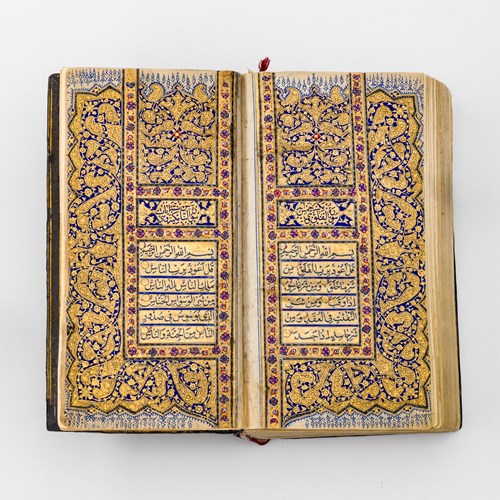Marketplace
Two Algerian Textile Panels (Tanchifa)
This pair of linen textiles embroidered with silk thread was made in 18th-century Ottoman Algeria. Though Algeria had a tradition of embroidery dating back centuries, it was only during the late 17th and 18th centuries that this distinctive polychrome design emerged, resulting both from the influence of the Ottoman Imperial Workshop during the Regency of Algiers (1516-1830) and the fashions from the great Italian ateliers.
At the end of the Middle Ages, a silk industry was created in Algeria by Muslims who had been expelled from Spain during the Reconquista. Following a visit to Cherchell, the Andalusi diplomat Leo Africanus said that the former inhabitants of Grenada had ‘devoted themselves to silk-making’.1 At the beginning of the 17th century, an embroidery craze took hold of the Topkapı.2 This soon spread to the Ottoman ruling elite in Algeria, who commissioned embroideries of their own from indigenous artisans. The preponderance of reds and blues in designs of this period may even stem from the colour of Ottoman army uniforms.3
This textile is embroidered with a pattern known as ma’alka.4 The design features familiar motifs from Ottoman art, including carnations, prunus blossom, and saz leaves. Each element is outlined in black stem stitch. The arrangement of the floral elements in palmettes and pomegranate shapes resembles the patterns on the Italian renaissance silks which were so desired by Ottoman sultans. A caftan which purportedly belonged to Sultan Murad IV, with similar motifs albeit in gold and white, is housed in the Topkapı Palace Museum (accession no. 13/838).5 It was made in Italy in the 16th century. A portrait of Orhan Çelebi in the Munich Pinakothek (accession no. 2236) by a follower of Veronese in the 16th century shows a fabric dominated by red, blue, and yellow with large palmettes, likely made in Italy.
Embroidered textiles with this repertoire of designs served the purpose of fashion and furnishing in Algerian society. Their use can sometimes be determined by their shape. Large, square panels were used as turban covers, an 18th-century example of which can be seen in the Walters Art Museum (accession no. 83.178). Textiles with unembroidered areas can be identified as headwear: narrow textiles with a thin strip of plain linen at the centre are beniqa, to be used at the hammam to wrap up wet hair; and rectangular panels with an untouched circle at the centre are used as headscarves (tanchifa). An example of the former is in the Harvard Art Museum, Cambridge MA (accession no. 1927.270) and the latter at the the Musée de Quai Branly, Paris (accession no 74.1967.11.2), both dating to the 18th century. Embroidered linen was a popular material for curtains. Strips of 2.5 to 3m in length, such as a panel at the Institut du Monde Arabe (accession no. AI 03-07), were sewn together to create portières, or curtains to cover doors, such as the example in the Musée de Quai Branly (accession no. 71.1967.33.12).
Two textiles held in the Musée de Quai Branly, both dated to the 18th century and described as wall hangings, bear particular comparison (accession nos 74.1962.0.787 and 71.1961.74.122). All three are of similar proportions – the present pair are each 51.5 x 80cm, whilst the two in Quai Branly are 42 x 73cm and 53 x 91cm – with extremely similar design. They are all embroidered with a large mandorla of flowers at the centre, with borders of delicate polychrome blossoms. Neither the shape nor the design of the present textile gives away its intended function. However, it is likely to be a household furnishing like a cover for a mirror, furniture, or wall. It might also be a variation of a tanchifa, to be worn around the shoulders rather than as a headscarf.
n.b. accession nos are clickable links
1 ‘Sont adonnés au métier de la soye’. Jean-Léon l’Africain. Description de l’Afrique, A. Epaulard (trans.) Paris: 1956. In Mehadji, Najia. La trace et le souffle. Paris: Somology éditions d’art, 2018. p. 155.
2 Roux, Jean-Paul (ed.) L’Islam dans les collections nationales. Paris: Réunion des Musées nationaux, 1977. P. 229-230.
3 Radia, Bouadjina. ‘Broderie d’Alger: Un Entrecroisement d’art et d’histoire’, La revue d’études archéologiques 20.1 (2022) pp 479-492: p. 484.
4 Radia. Op. Cit. p. 483.
5 Pictured in De Margerie, Anne (ed.) Topkapi à Versailles: Trésors de la Cour ottomane. Paris: Réunion des Musées nationaux 1999. Exh. Cat. P. 93, cat. 47.
More artworks from the Gallery


_T638563967127366840.jpg?width=2000&height=2000&mode=max&scale=both&qlt=90)






